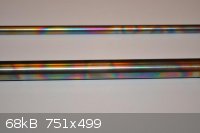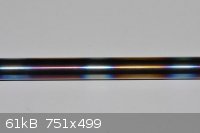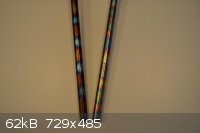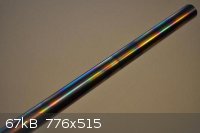Morgan
International Hazard
    
Posts: 1667
Registered: 28-12-2010
Member Is Offline
Mood: No Mood
|
|
Iridescent anthracite
What makes these colors I wonder?
http://www.flickr.com/photos/hankrogers/7811438654/in/set-72...
http://theamericanscholar.org/coal-is-a-rock-that-burns/
"In any case, the coal that washes up on area beaches frequently has a smooth polish from tumbling in the surf; at times it occurs in great abundance.
These often large chunks of anthracite that make beautiful laboratory hand specimens (or exceptional Christmas presents!). Some anthracite specimens
display iridescence or are of high quality to be considered "jet" - a jewelry grade of semiprecious coal."
http://3dparks.wr.usgs.gov/nyc/shoreline/seacoal.htm
[Edited on 13-3-2013 by Morgan]
|
|
|
hissingnoise
International Hazard
    
Posts: 3940
Registered: 26-12-2002
Member Is Offline
Mood: Pulverulescent!
|
|
More fine specimens here.
A tentative explanation too.
Trippy coal?
|
|
|
SM2
Hazard to Others
  
Posts: 359
Registered: 8-5-2012
Location: the Irish Springs
Member Is Offline
Mood: Affect
|
|
I'd imagine some birefrigant effect. Definitely a surface effect. Multiple ultra thin (translucent) layers of carbon, arranged slightly off tangent
could have this effect.
Or, imagine a droplet of engine oil in a puddle of water, and similar rainbow of pastels being created. Both thin (surface effect), and in this case,
both petroleum products.
[Edited on 13-3-2013 by SM2]
|
|
|
watson.fawkes
International Hazard
    
Posts: 2793
Registered: 16-8-2008
Member Is Offline
Mood: No Mood
|
|
From the page cited: | Quote: | | A rare find, miners sometimes collect coal naturally colored with purples, reds, yellows, and blues...sometimes even in ROYGBIV order.
|
It's called thin-film interference. Seeing rainbow-ordered colors means that the film is changing thickness.
|
|
|
Morgan
International Hazard
    
Posts: 1667
Registered: 28-12-2010
Member Is Offline
Mood: No Mood
|
|
Most colorful! There's one photo that appears it has some quartz in with the coal, the one that looks like opal. And some of the hues are different,
less like an oil on water, bismuth, or anodized titanium look, "softer" than the latter three. A good red color isn't seen with a titanium spectrum.
If there're an easy way to thin film deposition some metal oxides on my meter lengths of 25mm quartz tubing, I'd like to try making some colorful
designs or patterns as an art project. Here's some grey titanium tubing I heated with a propane torch sitting on the back porch, in different light
the vividness changes. Also handling them often eventually dulls the color.
  
[Edited on 14-3-2013 by Morgan]

[Edited on 14-3-2013 by Morgan]
|
|
|
AndersHoveland
Hazard to Other Members, due to repeated speculation and posting of untested highly dangerous procedures!
    
Posts: 1986
Registered: 2-3-2011
Member Is Offline
Mood: No Mood
|
|
Some types of coal contain a portion of hydrocarbons, the most extreme of example of this being the mineral jet, a form of lignite. It is likely that
these viscous oily layers are causing interference effects. I have also seen some hard acrylic plastics that seem to have a slight iridescent
appearance (and when a laser is shown through there are obvious interference effects with bands forming). I have read it has something to do with
stress in the plastic when it was being formed.
[Edited on 14-3-2013 by AndersHoveland]
|
|
|